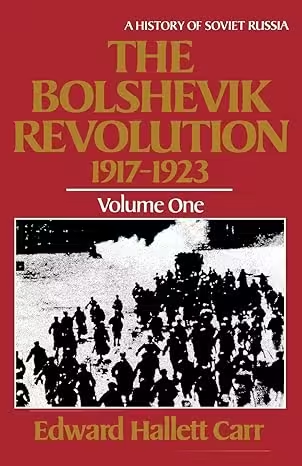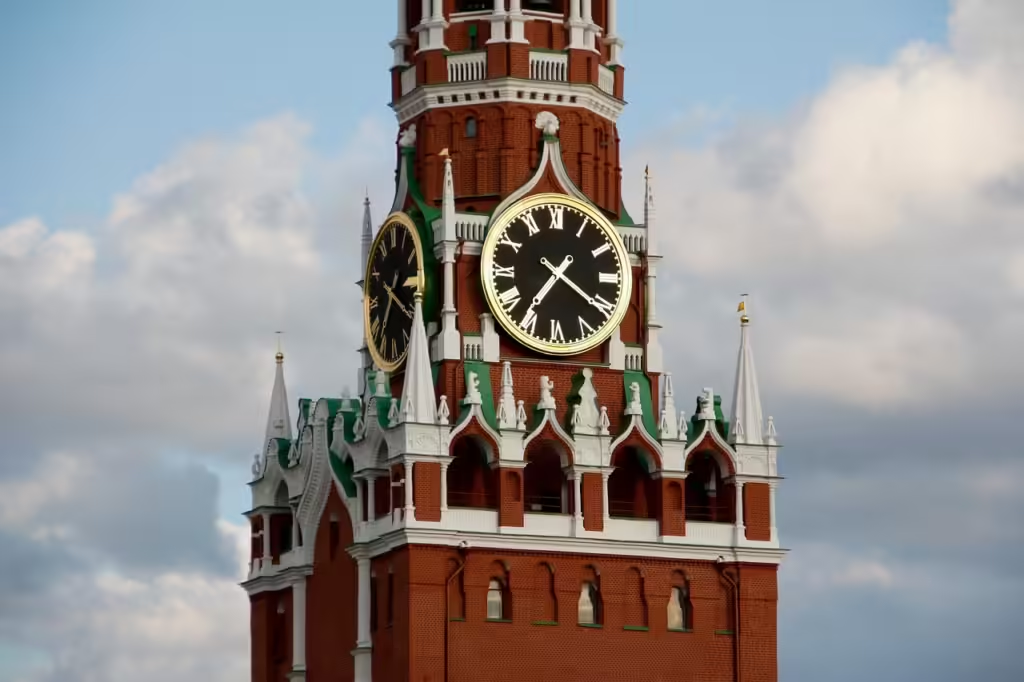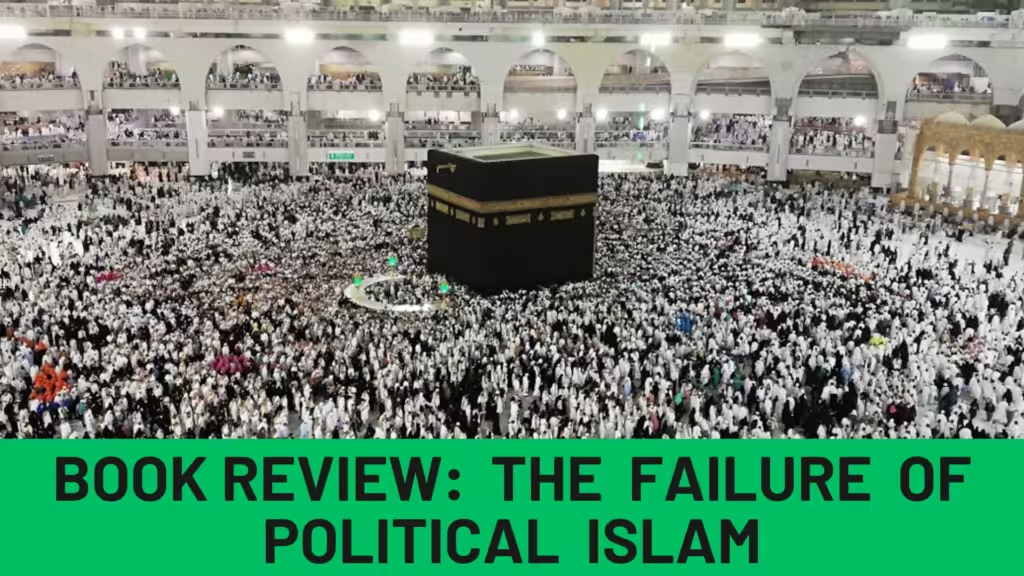Edward Hallett Carr is perhaps the greatest and most authentic authority when it comes to the History of the USSR. His pioneering works on history and international relations have immensely contributed to scholarships in the respective fields of study. He is best known for his fourteen-volume History of the USSR, which was the first comprehensive study of the history of the Socialist country, thus making this work of his a foundational work in the literary and academic field.

With his peculiar way of explaining historical events, he uses original sources to write his masterpiece. His original aim was not to write the history of the country as a series of events of the revolution but as a history concerning the political, social and economic order that emerged thereafter. This is evident in each chapter where instead of just explain chronology of events, he discusses the impacts of the policies.
Initially planned as a chapter in his book, Carr was compelled to transform it into a volume. The book consists of three parts namely The Man and the Instrument, The Constitutional Structure and Dispersal and Reunion. He begins with a description of the Bolshevik Party’s history, in which he describes Bolshevism’s political outlook and organisational ideas as they developed between 1903 and 1917.
He then moves on to a discussion of the Soviet Republic’s constitutional aspects between 1917 and 1923. The character of the Soviet regime, the organisation of Lenin’s Government, and the ties between the Soviets, the Kremlin, and the Party, which led to the unification of Party and State and the creation of a single-party system, are all crucial issues here. He also highlights clear differences between the constitutional theory and the unescapable practicality.
Carr traces the key stages by which the Bolsheviks reassembled much of the pieces of the Russian empire that had broken apart during the Revolution and Civil War within the Soviet Union in the volume’s final portion. His history focuses on the early years of Soviet rule, with about a third of the Volume he devoted to events that occurred before the Soviets arrived.

It seems almost self-evident that the tale of these crowded and tormented years cannot be told without at least a description of the social, political, and economic forces that contributed to the two 1917 revolutions, since the Bolsheviks’ new order had to be founded on the framework that they inherited from a long line of predecessors.
Carr throughout his book holds a particular viewpoint. Carr depicts the dilemma of a group of extremists who have taken power in Russia without warning, recklessly plunging into the pit from which their fellow Socialists in Russia and Western Europe have recoiled. They have struck, filled with a quasi-religious faith that their success in Russia would start a chain reaction of proletarian revolutions in the crumbling capitalist world; that, dealing with like-minded groups in every country and supported by the free proletarian masses, they will somehow build a wondrous world.
Critiquing Carr’s Style of Writing
The book has been nonetheless prone to criticism of his style of writing and his broad generalizations and vague conceptions of certain terms such as ‘bourgeoisie’. Carr says nothing about the philosophy of the Socialist-Revolutionary Party, which was a part of the early Soviet governments and whose land policy the Bolsheviks attempted to implement in 1917-1918. He describes the Socialist-Revolutionaries as “an avowedly revolutionary and terrorist group that had much less to expect from Tsarist generals and their supporters than the Mensheviks. The single-party government had not yet achieved the uniformity of outlook that would later become characteristic of it in the early years of the Bolshevik regime. The Bolshevik Party was almost always divided into classes and factions, each of which freely expressed their opinions and disagreements.
The Bolshevik literature of those years is full of controversies, in which facts and views, some of which were highly damaging to the government, were openly revealed. As a result, an altera pars could be clearly heard on almost any major policy issue the only difference was that it, too, was in the ruling party’s ranks.
When the historian moves on to the later period, when all public debate among Bolsheviks has ceased, the historian faces a real and nearly insurmountable challenge. Mr Carr, on the other hand, has a long way to go before he reaches that point. Mr Carr is said to portray the Bolshevik Revolution as an unavoidable phase, and that he sees history through the eyes of the victor.
Many features that would otherwise invite critical debate are explained by the fact that these three volumes are intended as an introduction to a larger project. The manner in which he follows up the first volume on political institutions with another on economics and the last of the three on international relations – i.e., allowing the presentation of the Party’s institutional growth to be followed by a review of the elements that determined the Party’s behaviour – is perfectly reasonable if these volumes are conceived as a presentation of the main actor in the historical drama. However, it does not constitute a logical correlation chain.

Carr tends to suggest that the underlying problem in the debate between legal Marxists and Economists was one that had dogged the Russian Revolution throughout its history. The Communist Manifesto’s well-organized scheme called for revolution in stages. The bourgeois revolution would first overthrow the remnants of the feudal order and political absolutism, establishing bourgeois democracy and bourgeois capitalism, together with the attendant phenomenon of an industrial proletariat; then the proletariat, organising itself under the conditions provided by bourgeois democracy, would proceed to the final revolution, overthrowing bourgeois capitalism and establishing an industrial proletariat.
Marx, on the other hand, seemed to have reservations about applying this plan, which was the result of a clever generalisation from English and French history, to the Germany of the 1840s, which was still waiting for its bourgeois revolution but already had a burgeoning industry and a rapidly expanding proletariat. In 1844, Marx questioned whether the coming German revolution could be contained within the confines of a bourgeois revolution “that leaves the pillars of the house standing,” and proclaimed that Germany could only be freed by the revolutionary proletariat.
A continuous stream of evidence can be found in any analysis of specific institutions of Soviet society, such as law or economic organisation, leading from the early days of the N.E.P. to the present, while the entire preceding era may serve as a kind of pre-history that provides some interesting clues to developments. As a result, there is a case to be made for beginning the study of temporary institutions (as opposed to their origins) with the implementation of the N.E.P. or with Lenin’s slogan “It is time to stop the retreat!” in the early summer of 1922 when the full extent of the sacrifices needed to get the economic machinery going again became apparent.
Carr claims that just as the party appeared to consume the establishment by crushing its competitors, the state now absorbed the Party into itself.” He considers the debate between Zinoviev and Stalin about whether the Party should govern directly or through a system of ‘transmission belts,’ or mass organisations controlled by it, to be of secondary importance, given that the basic reality of the Party’s direction of all forms of public action was undeniable. Such ‘details,’ and the position that they were obligated to play under the N.E.P. conditions, seem to me to be the mechanisms by which sociological changes occur.

Carr continues, “An interpretation of Marxism that assumed that subsequent stages of revolution elsewhere in the world would follow a trend developed in Western Europe was deterministic and therefore false.” What is implied by ‘determinism’ in this context is crucial. Professor Carr’s denunciation of determinism is obviously right if it means that history renders itself through blind instruments that go through some traditional procedures on its own level. However, he describes, in one of his book’s most enthralling remarks, how human acts were ultimately calculated, with the result that history’s causal explanation prevents its mechanical repetition.
As per Carr, the overthrow of the monarchy sparked a campaign for the Empire’s disintegration. According to Professor Carr, “Lenin’s astonishing accomplishment” and “an excellent tribute to Lenin’s genius as a positive statesman” were stopping this destructive trend and bringing national minorities into the fold of the USSR. This startling finding, like so many others in Professor Carr’s book, does not seem to be based on the evidence he has gathered.
The fate of the border territories was decided by geographical factors, historical tradition, the amount of national self-consciousness, and the social and cultural levels of national minorities, not by Kremlin policies. Finland, Russian Poland, Latvia, Estonia, and Lithuania were unconcerned about the nuances of Bolshevik national policies and rushed to free themselves from the oppressive Muscovite yoke. The national movements in Belorussia (White Russia) and Ukraine (at least in Russian Ukraine) grew slowly and artificially, with little hope of succeeding.
Carr does stress the fact that the Bolshevik policies ‘worked,’ and only an anti-Bolshevik historian addicted to retrospective wishful thinking might argue otherwise. The measure of any policy, however, is not its short-term success or failure. Carr’s emphasis on Bolshevism’s positive achievements seems to be a response, at least in part, to existing anti-Bolshevik literature’s self-righteous and pointless cliches. Part of his politico-constitutional approach, as opposed to his sociological approach, leads him to concentrate his attention on the Revolutionary War chiefs and to be preoccupied with the function of leadership.
This may have been less decisive and self-sufficient than it appears in this novel, despite its importance. The position of the Bolshevik leadership appears to loom larger here than that of the Russian people, and it appears to have dominated the Revolution’s overall atmosphere. This, on the other hand, seems to be a problem of perspective rather than partisanship.
Conclusion
To conclude, Carr’s book is a significant contribution to understanding the Soviet mind, even though it isn’t quite what it claims to be a history of the Bolshevik Revolution. Although Part First (“The Man and the Instrument “), which focuses on the dreaded Bolshevik-Menshevik feud, brings nothing new to the discussion, Part Second (” The Constitutional Structure “) and Third (” Dispersal and Reunion “) are extremely insightful and shed light on the evolution of Soviet constitutional law.




